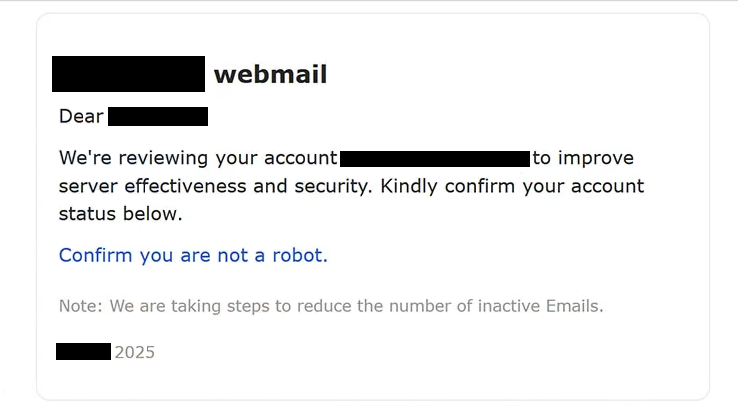Remove “Reviewing Account To Improve Server Effectiveness And Security” email
The “Reviewing Account To Improve Server Effectiveness And Security” email is a phishing attempt targeting your email login credentials. The email is disguised as a security notification from your email provider, supposedly informing you that you need to confirm your account status. If you interact with the email, you will be taken to a phishing site and asked to log in to your email account. If you do, your email credentials would be stolen, allowing malicious actors to access your account.
The “Reviewing Account To Improve Server Effectiveness And Security” phishing email is disguised as an alert from an email provider, supposedly informing the account holder that their account is under review and needs to be confirmed. This is supposedly a measure to reduce the number of inactive email accounts, implying that the account will be deleted if action is not taken. The email has a “Confirm you are not a robot” button, which would lead users to a phishing site.
If you enter your login information on a phishing website, you unwittingly hand over your credentials to the malicious actors behind the phishing campaign. These stolen credentials can then be used to log into users’ accounts. Email account credentials, in particular, are a hot commodity among cybercriminals. Email accounts not only contain a wealth of personal and sensitive data but are also linked to various other accounts. If malicious actors gain access to your email account, they may be able to access other accounts as well. Even if the cyber criminals don’t use the stolen credentials themselves, they can sell them to other malicious actors.
Here is the full “Reviewing Account To Improve Server Effectiveness And Security” email text:
Subject Confirm you are not a robot
– webmail
Dear -,
We’re reviewing your account – to improve server effectiveness and security. Kindly confirm your account status below.
Confirm you are not a robot.
Note: We are taking steps to reduce the number of inactive Emails.
– 2025
How to recognize phishing emails
The very first line in this “Reviewing Account To Improve Server Effectiveness And Security” email is enough to give away the phishing attempt. The email addresses you with your email username, which is an immediate red flag. Your actual email service provider will address you by the name you registered with. Generic phishing attempts typically come from malicious actors who do not have access to a lot of personal information, which is why they use generic words or users’ email usernames. If the sender should know your name but does not use it in the greeting, you might be dealing with a phishing email.
Whenever you receive unsolicited emails that include attachments or links, you must verify the sender’s email address before interacting. A lot of low-effort phishing emails often originate from fake or suspicious-looking email addresses. More sophisticated phishing emails may come from addresses that seem legitimate, but doing a quick online search can help verify the authenticity of the email address. If you can’t find any information on the address, it’s probably a phishing attempt.
Another indicator of phishing is poor grammar or misspellings in the email. Many phishing emails are full of mistakes—typos, incorrect punctuation, or unusual spacing—while legitimate ones, particularly concerning account security, are typically well-written and professional.
Even if a phishing email looks polished, the links can reveal the phishing attempt. By hovering your mouse over the links, you can preview where they will take you. If any link appears suspicious, do not click on it. Be cautious; scammers often use tricks to disguise links by altering or rearranging letters.
To avoid accidentally entering your login credentials on a phishing site, it’s best to avoid clicking on links in emails altogether. Instead, go directly to your accounts through a web browser, especially if the email alerts you to an issue with your account. Remember, while a phishing site may closely resemble a legitimate one in design, the URL will usually give it away. Make it a habit to check the URLs of any sites you visit; if something seems off, don’t enter your login details.
Remove “Reviewing Account To Improve Server Effectiveness And Security” email
You can just delete “Reviewing Account To Improve Server Effectiveness And Security” email, as it is simply a phishing attempt. If you have clicked on any links in the email and entered your email login information on a questionable site, change your password immediately. If you suspect your account has been compromised and you can’t access it, use all recovery options available. If you’re still unable to regain access, ensure that you disconnect your email from any connected accounts.
Site Disclaimer
WiperSoft.com is not sponsored, affiliated, linked to or owned by malware developers or distributors that are referred to in this article. The article does NOT endorse or promote malicious programs. The intention behind it is to present useful information that will help users to detect and eliminate malware from their computer by using WiperSoft and/or the manual removal guide.
The article should only be used for educational purposes. If you follow the instructions provided in the article, you agree to be bound by this disclaimer. We do not guarantee that the article will aid you in completely removing the malware from your PC. Malicious programs are constantly developing, which is why it is not always easy or possible to clean the computer by using only the manual removal guide.

